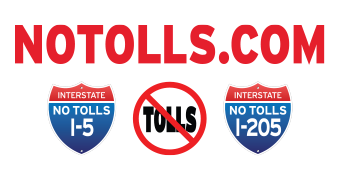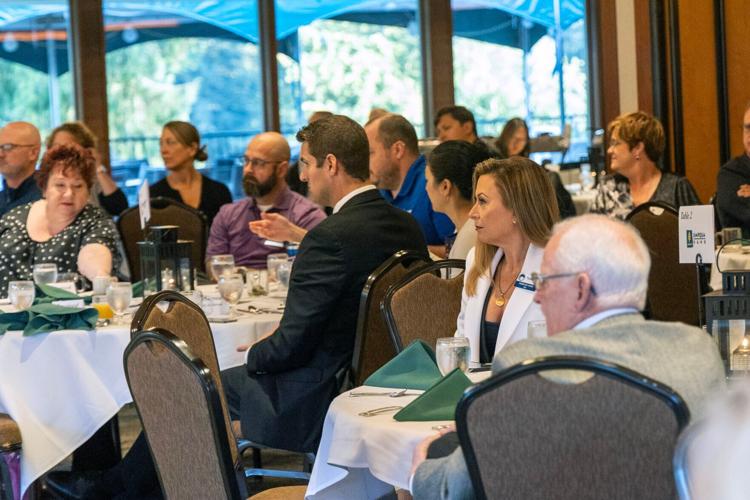Tualatin Chamber hosts “Key Leaders” discussion on tolling
By Ray Pitz — Portland Tribune Sept. 26, 2023
Local leaders, state representatives and transportation officials continue to discuss the pitfalls — and merits — of plans to toll along Interstates 205 and 5 between the Columbia River and Wilsonville.
On Friday, Sept. 22, the Tualatin Chamber of Commerce’s Business Advocacy Council hosted a panel to discuss the hotly debated topic on tolling, with the majority of its focus aimed at proposals to toll along I-205.
The Oregon Department of Transportation’s mandate to toll those roads came out of House Bill 2017, the biggest transportation funding package in state history, which was approved in 2017.
However, this past spring, Gov. Tina Kotek put the brakes on tolling implementation for one year as those projects are reviewed.
The Tualatin Chamber hosted a similar discussion in fall 2022 on the same topic. But three new factors have been thrown into the mix since then, including Kotek’s moratorium.
ODOT recently announced the indefinite postponement of a third lane planned between Stafford Road and Oregon City’s Abernethy Bridge.
The department also scrapped plans to toll bridges that cross the Tualatin River along I-205 about six miles west of Oregon City’s Abernethy Bridge. Remaining as part of the plan, however, are plans to add tolls on the Abernethy Bridge.
The Oregonian/OregonLive.com first reported the changes Sept. 15.
“We are indefinitely postponing phase 2 of the I-205 Improvements Project, which includes the third lane and seismic upgrades to several bridges. We are focused on finishing the Abernethy Bridge to make it earthquake-ready and that is expected to be complete in 2025,” ODOT said in a statement to KOIN 6 News, a Pamplin Media Group news partner, also on Sept. 15.
In Tualatin
The Sept. 22 gathering at the Tualatin Country Club included Frank Bubenik, mayor of Tualatin; Rory Bialostosky, mayor of West Linn; Travis Brouwer, assistant director of the Oregon Department of Transportation; Jana Jarvis, president and chief executive officer of the Oregon Trucking Association; and two state representatives, Jules Walters of West Linn and Susan McLain of Forest Grove.
One of the questions posed was how tolling might impact local business, with Tualatin’s Mayor Bubenik saying employers are already challenged in recruiting talented personnel.
“With tolling and that additional cost to commute to and from work, they’re trying to figure out how they can attract folks to their businesses, and would that require a pay raise?” Bubenik asked. “Would it have to be subsidies for the tolls?”
Ultimately, the mayor said tolls will hit local businesses’ bottom lines.
However, ODOT’s Brouwer focused on the benefits of tolling, pointing out that it will address some of the region’s congestion challenges. Among those, he said, are rankings that place Portland as the 15th-worst area for congestion in the nation and 37th-worst in the world. He said congestion is already having a negative impact on businesses in the region.
“Tolling really is going to be a way for us to help build the projects in our urban mobility strategy that we’ve laid out … to the Boone Bridge over the Willamette River, to the Rose Quarter and Interstate Bridge over the Columbia,” said Brouwer.
He said without making those improvements, the region is “going to see gridlock becoming increasingly worse over time.” He added that ODOT sees tolling as probably the only way to pay for those projects.
The trucking association’s Jarvis said when the association supported HB 2017, it understood that its passage would be dependent on some area tolling.
Like Brouwer, she highlighted the region’s notoriety for traffic congestion, saying the American Transportation Research Institute annually cites the top 100 bottlenecks in the nation “and the Portland metro region has three of them: the I-5 bridge, the Rose Quarter and I-205.”
West Linn worries
West Linn Mayor Bialostosky said he hears concerns from West Linn businesses regarding impacts along Willamette Falls Drive and Highway 43 as to whether people would be able to access small businesses in those areas with ease if tolling is put into place.
He said the analysis from the environmental assessment for I-205 tolling showed that traffic would as much as double along Willamette Falls Drive, with drivers trying to avoid the tolls.
Bialostosky also said he has concerns about “commuting equity.”
“If you’re commuting from West Linn to downtown Portland and you want to use the interstate under the current plan, you would have to potentially pay several tolls maybe three or four (or) five. But if you’re commuting from, say, Gresham or Hillsboro or Beaverton to downtown Portland and you want to use the interstate, under the current plans, you don’t have to pay anything, any tolls,” he said.
Rep. Walters said she had a businessperson tell her that his two employees would have to quit their jobs because they could not afford the tolls. She said most of the trips taken in the Abernethy Bridge corridor are local trips taken by residents to visit their doctor or to shop at their local grocery store.
“So, this particular tolling plan, in my opinion, is deeply flawed in that it’s inequitably putting this toll on the backs of people that live in Tualatin and Lake Oswego and Oregon City, Gladstone, West Linn, the entire surrounding neighborhoods here,” said Walters, whose House District 37 includes Tualatin and West Linn both, “and we’re supposed to (foot) the bill to pay for all of this infrastructure that needs to be built and repaired across the state.”
Diversion
A portion of the panel discussion focused specifically on problems related to diversion.
As panel moderator Daniel Lacy, editor of OregonTollingUpdates.com, defined it: “If you don’t want to go on the toll road, you’re going to go on the side streets, that’s diversion.”
Walters said it’s already hard to get up and down Southwest Nyberg Road and other major streets in the Tualatin area. She said the fact ODOT has scrapped plans for a third lane along I-205 will make congestion even worse.
But Rep. McLain said that even if tolling isn’t the ultimate answer, the state needs to find a funding mechanism that doesn’t hurt anybody. She added that the intent of HB 2017 was to commit to an equitable and fair system to pay for road improvement.
“It’s unacceptable not to talk about new revenue. And it’s unacceptable to honestly believe that ODOT is a mess,” said McLain.
McLain also said money coming from tolling in the corridor would be spent on local roads affected by diversion.
But Bubenik said that diversion needs to be addressed sooner rather than later.
“If Borland (Road) is buried on day one (of tolling), how long it will take to get Borland fixed? Usually that’s years when it comes to these kinds of projects,” Bubenik said.


